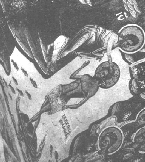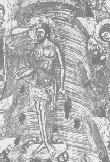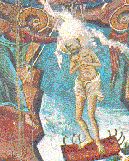The Cheirograph as a Contract with Satan
The following images range in date from the late 11th century to the 19th century, and are identified by date,provenance, and current location.
 Baptism of Jesus, ilustration of Ps. 73
Baptism of Jesus, ilustration of Ps. 73
Vatican, codex Barberini gr. 372, fol. 120r, marginal illustration to Psalm 73. Manuscript dated to ca. 1092. Source: D.E. Miner, The "Monastic" Psalter of the Walters Art Gallery, in K. Weitzmann (ed.), Late Classical and Medieval Studies in honor of Albert Mathias Friend, Jr., Princeton University Press, Princeton, N.J., 1955, pp. 232-253, pl. XXXI.
 Baptism of Jesus, ilustration of Ps. 73
Baptism of Jesus, ilustration of Ps. 73
Walters Art Museum (Baltimore), Walters cod. W 733, fol. 34r, marginal illustration to Psalm 73. Manuscript dated to the early 12th century. Source: D.E. Miner, The "Monastic" Psalter of the Walters Art Gallery, in K. Weitzmann (ed.), Late Classical and Medieval Studies in honor of Albert Mathias Friend, Jr., Princeton University Press, Princeton, N.J., 1955, pp. 232-253, pl. XXXI.
From the exonarthex of the monastery in Sucevita, Walachia, founded before 1584 and completed ca. 1600. The inscription near Jesus reads "the Cheirograph of Adam." Source: P. Henry, Les Eglises de la Moldavie du Nord: des origines a la fin du xvi siecle, Monuments de l'art Byzantin, VI, Paris, 1930, pl. LXIII.1.
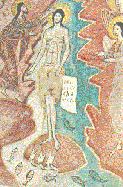 The baptism of Jesus, Manuscript illustration
The baptism of Jesus, Manuscript illustration
From an illustrated manuscript from the scriptorium of Atanasiu Crimca of the cloister of Dragomirna, northwest of Suceava, Romania, dated 1602. Now in the Cloister museum of Dragomirna. Jesus holds a copy of the cheirograph in his hand. Source: L. Kretzenbacher, Bilder und Legenden: Erwandertes und erlebtes Bilder-Denken und Bild-Erzahlen zwischen Byzanz und dem Abendlande, Klagenfurt, 1971, color plate IV.
Icon of Jesus baptized while standing on the Satan-stone, from Asia minor, ca. 1600. Original 27.5 cm x 21.7cm, now in the collection of Dr. S. Amberg-Herzog, Switzerland. Photograph by M.E. Stone.
From a tile on an iconostastis in Tirgoviste, late 17th century. Source: L. Kretzenbacher, Bilder und Legenden: Erwandertes und erlebtes Bilder-Denken und Bild-Erzahlen zwischen Byzanz und dem Abendlande, Klagenfurt, 1971, plate XIV.
A baptism scene painted on a wall of a church in Romanian Walachia from the beginning of the 18th century. Source: L. Kretzenbacher, Bilder und Legenden: Erwandertes und erlebtes Bilder-Denken und Bild-Erzahlen zwischen Byzanz und dem Abendlande, Klagenfurt, 1971, plate XVI.
An icon from Romania-Walachia of the 19th century. Note the tablet-like appearance of the stone upon which Jesus stands is deliberately unnaturalistic. Source: L. Kretzenbacher, Bilder und Legenden: Erwandertes und erlebtes Bilder-Denken und Bild-Erzahlen zwischen Byzanz und dem Abendlande, Klagenfurt, 1971, plate XV.
A painted cross from the Church of John the Baptist, Suceava, Romania, 1825. Source: L. Kretzenbacher, Bilder und Legenden: Erwandertes und erlebtes Bilder-Denken und Bild-Erzahlen zwischen Byzanz und dem Abendlande, Klagenfurt, 1971, color plate 5.
Wall decoration of the monastery of Cozia on the Olt, Romania, beginning of the 19th century. Source: L. Kretzenbacher, Bilder und Legenden: Erwandertes und erlebtes Bilder-Denken und Bild-Erzahlen zwischen Byzanz und dem Abendlande, Klagenfurt, 1971, color plate 3.
The Cheirograph as the Obligations of the Law
The following images are all from illustrated incipits to the Epistle to the Colossians in French Vulgate Bibles from the first half of the thirteenth century.
 Paul declares the bondage of the Law to be broken
Paul declares the bondage of the Law to be broken
Incipit to the Epistle to the Colossians, Gottweig, Stiftsbibliothek, Ms. 55, fol. 269. Provenance assigned to Paris, ca. 1225-1235 on stylistic grounds.
Source: L. Eleen, The Illustration of the Pauline Epistles in French and English Bibles of the Twelfth and Thirteenth Centuries, Oxford: Clarendon Press, 1982, fig. 285.
 Paul declares the bondage of the Law to be broken
Paul declares the bondage of the Law to be broken
Incipit to the Epistle to the Colossians, Cambridge, Fitzwilliam Museum, Ms. 1, fol. 407v. Provenance assigned to Paris, ca. 1250-1260 on stylistic grounds.
Source: L. Eleen, The Illustration of the Pauline Epistles in French and English Bibles of the Twelfth and Thirteenth Centuries, Oxford: Clarendon Press, 1982, fig. 286.
 Paul declares the bondage of the Law to be broken
Paul declares the bondage of the Law to be broken
Incipit to the Epistle to the Colossians, Paris, Ste. Genevieve, Ms. 1180, The Maugier Bible, fol. 348v. Provenance assigned to Paris, ca. 1225-1235 on stylistic grounds.
Source: L. Eleen, The Illustration of the Pauline Epistles in French and English Bibles of the Twelfth and Thirteenth Centuries, Oxford: Clarendon Press, 1982, fig. 287.
 Paul declares the bondage of the Law to be broken
Paul declares the bondage of the Law to be broken
Incipit to the Epistle to the Colossians, Madrid, Fundacion Lazaro Galdiano, Inv. 15289, fol. 297v. Of French origin, ca. 1225-1235, but exact provenance uncertain.
Source: L. Eleen, The Illustration of the Pauline Epistles in French and English Bibles of the Twelfth and Thirteenth Centuries, Oxford: Clarendon Press, 1982, fig. 288.
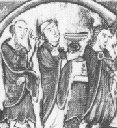 Paul declares the bondage of the Law to be broken
Paul declares the bondage of the Law to be broken
Incipit to the Epistle to the Colossians, formerly Florence, Olschki Collection, fol. 371v. Bible now lost, but this image is one of four remaining photographs of the text for the Pauline letters made between 1900-1910. Provenance and date unknown, but the extant photographs show a close relationship to Paris, Ste. Genevieve, Ms. 1180.
Source: L. Eleen, The Illustration of the Pauline Epistles in French and English Bibles of the Twelfth and Thirteenth Centuries, Oxford: Clarendon Press, 1982, fig. 289.
The Cheirograph as the Record of Individual Sins
images
